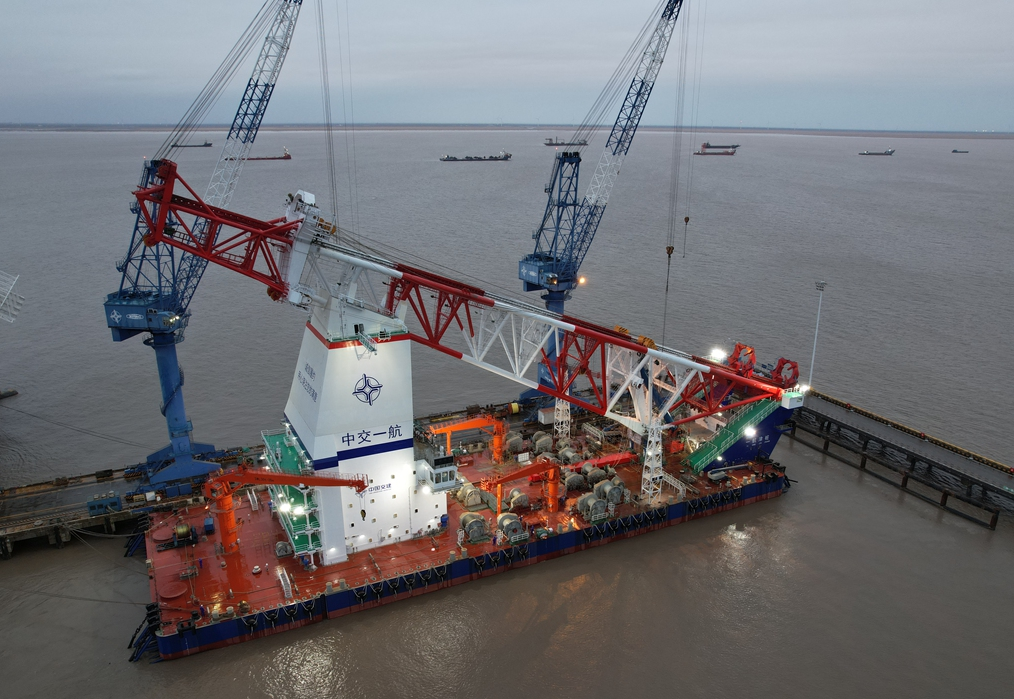World's largest pile-driving barge with Beidou system delivered in E.China
2023-02-27 15:46:55

The domestically designed and built, world's largest 140-meter-class pile-driving barge Yihang Jinzhuang, equipped with the Beidou Satellite Navigation System, was delivered in Nantong, East China's Jiangsu Province last Friday.
The Vessel can boost the efficiency of offshore construction projects such as cross-sea bridges, deep-water wharves and offshore wind farms under harsh sea conditions.
The floating pile driver with the world's highest pile frame, largest pile-lifting capacity, longest pile-driving length and strongest wind and wave resistance, is equipped with intelligent and digital technologies, including the Beidou system.
It was financed, researched and developed by China Communications Construction Co First Harbor Engineering Company and manufactured by Shanghai Zhenhua Heavy Industries Co.
It will be used in projects involving large pile foundations, pile group foundations, wind turbine jacket foundations, and wind power single-pile foundations, and it will play a pivotal role in the construction of large ports, cross-sea bridges, offshore wind farms and artificial islands.
Chen Xiangmiao, an assistant research fellow at the National Institute for South China Sea Studies, told the Global Times on Sunday that the barge can enhance China's capabilities in offshore operations and serve as a capacity reserve for the development of the South China Sea.
"However, there is still a long way to go in the application of it in the South China Sea, where the depth of water can be 1,000 meters," Chen said, noting that pile driving is the first step for construction work in deep sea areas.
The Yihang Jinzhuang, at 14,644 gross tons has a pile frame of 142 meters, roughly equal to the height of a 50-story building. With its maximum working pile length of 118 meters plus the depth of water, it can work in much deeper open seas.
Gao Xiaodong, leader of the on-site supervision group for the construction of the barge, said that pile driving is the first step in building a structure at sea.
In order to ensure stability, the depth of the piles driven into the bottom of the sea has to be twice the depth of the sea water. For example, a pile in sea water that is 40 meters deep has to be driven into the bottom of the sea for 80 meters in terms of depth, so the total length of the pile is at least 120 meters.
Zhang Ning, an engineer at the construction company, said when the height of a pile frame exceeds 100 meters, it is very difficult to ensure the strength and stability of the structure. The company managed to make it as strong as possible and as light as possible by optimizing the structure and choosing the appropriate steels.
By driving piles of 700 tons in weight and six meters in diameter, the piling ship can reduce the number of piles driven and raise the efficiency of construction. With its wind resistance of fresh gales and wave resistance of 1.8 meters, it can operate in the bad sea conditions.
The pile-driving barge is also equipped with China's domestically developed Beidou system, which will be used in navigation during voyages, accurate positioning during operations, and sending messages where there is no 4G signal.
According to Kang Yuxing, captain of the ship, the linkage between the Beidou system and the electrical auxiliary propulsion system also achieves a function similar to autonomous driving in a car.
Within a certain range, the ship can adjust its position automatically by setting coordinates, which improves efficiency and saves fuels.
Kang believes that the pile-driving barge will also help support construction work overseas, especially infrastructure development under the Belt and Road Initiative in foreign countries and regions.
